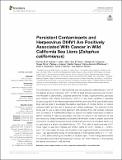Files in this item
Persistent contaminants and herpesvirus OtHV1 are positively associated with cancer in wild California Sea Lions (Zalophus californianus)
Item metadata
| dc.contributor.author | Gulland, Frances M. D. | |
| dc.contributor.author | Hall, Ailsa J. | |
| dc.contributor.author | Ylitalo, Gina M. | |
| dc.contributor.author | Colegrove, Kathleen M. | |
| dc.contributor.author | Norris, Tenaya | |
| dc.contributor.author | Duignan, Pádraig J. | |
| dc.contributor.author | Halaska, Barbie | |
| dc.contributor.author | Acevedo Whitehouse, Karina | |
| dc.contributor.author | Lowenstine, Linda J. | |
| dc.contributor.author | Deming, Alissa C. | |
| dc.contributor.author | Rowles, Teresa K. | |
| dc.date.accessioned | 2020-12-11T16:30:08Z | |
| dc.date.available | 2020-12-11T16:30:08Z | |
| dc.date.issued | 2020-12-10 | |
| dc.identifier | 271624820 | |
| dc.identifier | 979fe3d7-4418-438a-9917-7a818609dbb3 | |
| dc.identifier | 000600134300001 | |
| dc.identifier | 85098191431 | |
| dc.identifier.citation | Gulland , F M D , Hall , A J , Ylitalo , G M , Colegrove , K M , Norris , T , Duignan , P J , Halaska , B , Acevedo Whitehouse , K , Lowenstine , L J , Deming , A C & Rowles , T K 2020 , ' Persistent contaminants and herpesvirus OtHV1 are positively associated with cancer in wild California Sea Lions ( Zalophus californianus ) ' , Frontiers in Marine Science , vol. 7 , 602565 . https://doi.org/10.3389/fmars.2020.602565 | en |
| dc.identifier.issn | 2296-7745 | |
| dc.identifier.other | Bibtex: 10.3389/fmars.2020.602565 | |
| dc.identifier.other | ORCID: /0000-0002-7562-1771/work/85167827 | |
| dc.identifier.uri | https://hdl.handle.net/10023/21133 | |
| dc.description | This work was funded by the Geoffrey Hughes Fellowship, the National Institutes of Health (Fogarty International Center) and National Science Foundation joint program for the Ecology of Infectious Disease, the National Marine Fisheries Service Marine Mammal Heath and Stranding Program, and the Natural Environment Research Council grant number NE/R015007/. | en |
| dc.description.abstract | The prevalence of cancer in wild California sea lions (Zalophus californianus) is one of the highest amongst mammals, with 18–23% of adult animals examined post-mortem over the past 40 years having urogenital carcinoma. To date, organochlorines, genotype and infection with Otarine herpesvirus-1 (OtHV-1) have been identified in separate studies using distinct animals as associated with this carcinoma. Multi-year studies using large sample sizes to investigate the relative importance of multiple factors on marine mammal health are rare due to logistical and ethical challenges. The objective of this study was to use a case control approach with samples from 394 animals collected over 20 years in a multifactorial analysis to explore the relative importance of distinct factors identified to date as associated with sea lion cancer in the likelihood of sea lion carcinoma. Stepwise regression indicated that the best model to explain carcinoma occurrence included herpesvirus status, contaminant exposure, and blubber depth, but not genotype at a single microsatellite locus, PV11. The odds of carcinoma was 43.57 times higher in sea lions infected with OtHV-1 (95% CI 14.61, 129.96, p <0.001), and 1.48 times higher for every unit increase in the loge[contaminant concentrations], ng g–1 (an approximate tripling of concentration), in their blubber (95% CI 1.11, 1.97, p <0.007), after controlling for the effect of blubber depth. These findings demonstrate the importance of contaminant exposure combined with OtHV1 infection, in the potential for cancer occurrence in wild sea lions. | |
| dc.format.extent | 13 | |
| dc.format.extent | 1849153 | |
| dc.language.iso | eng | |
| dc.relation.ispartof | Frontiers in Marine Science | en |
| dc.subject | Cancer | en |
| dc.subject | Organochlorines | en |
| dc.subject | Sea lions | en |
| dc.subject | Herpesvirus | en |
| dc.subject | Microsatellite | en |
| dc.subject | Case control study | en |
| dc.subject | GC Oceanography | en |
| dc.subject | QL Zoology | en |
| dc.subject | RC0254 Neoplasms. Tumors. Oncology (including Cancer) | en |
| dc.subject | DAS | en |
| dc.subject | SDG 3 - Good Health and Well-being | en |
| dc.subject | SDG 14 - Life Below Water | en |
| dc.subject.lcc | GC | en |
| dc.subject.lcc | QL | en |
| dc.subject.lcc | RC0254 | en |
| dc.title | Persistent contaminants and herpesvirus OtHV1 are positively associated with cancer in wild California Sea Lions (Zalophus californianus) | en |
| dc.type | Journal article | en |
| dc.contributor.sponsor | NERC | en |
| dc.contributor.institution | University of St Andrews. School of Biology | en |
| dc.contributor.institution | University of St Andrews. Sea Mammal Research Unit | en |
| dc.contributor.institution | University of St Andrews. Scottish Oceans Institute | en |
| dc.contributor.institution | University of St Andrews. Marine Alliance for Science & Technology Scotland | en |
| dc.identifier.doi | 10.3389/fmars.2020.602565 | |
| dc.description.status | Peer reviewed | en |
| dc.identifier.grantnumber | NE/R015007/1 | en |
This item appears in the following Collection(s)
Items in the St Andrews Research Repository are protected by copyright, with all rights reserved, unless otherwise indicated.

